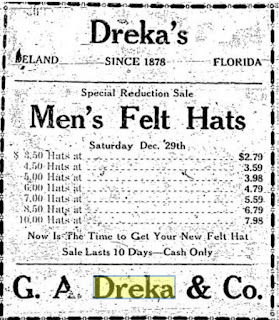 |
| These 1923 prices seem low from the distance of a century. But the modern equivalent is $50 to $140. |
People in the past probably felt the same about rising prices no matter when they lived. Particularly as they aged or lived through high-inflation periods. I thought it'd be interesting to do a cursory review of how much things cost a hundred years ago, in 1923. If only to be astonished at the differences.
My point of comparison is the once-famous Dreka Department Store in the Central Florida city of DeLand. It was founded in 1878 and operated for decades. The mercantile was so successful the owner, George A. Dreka, expanded in the early 1900s. He built the first reinforced concrete structure in the county in 1909. The showcase multistory building cost $75,000. Depending on which website you look at, that equates to between $1.9 and $2.5 million in modern dollars. The building is still around and is a downtown landmark.
Dreka's prided itself on selling everything a person could "eat, wear, and use." The store was a regular advertiser in the DeLand Sun News, which was the DeLand Daily News in 1923. Here's what some of the advertised items sold for in 1923:
- Ipswich Hosiery - for ladies, in wool and silk and in a range of brown and tan colors, plus white, $1 a pair. That's a hefty $17 today.
- Men's Felt Hats - these came in a range of prices, from $3.50 to $10. A sale in late December dropped those prices to $2.79 to $7.98. Translated to modern times, that's about $50 to $140. Not such a great bargain.
- Dresses, Capes and Coats - a special sale was being held, with $32.50 to $40 dresses available for $27.50, and $15 to $18 capes and coats for $11.75. They may have been on sale but they sure weren't cheap. Inflation calculators peg those 1923 prices as over $200 each today.
- Dollar Day - "Exceptional values in every department" were to be had Nov. 8, 1923, during a special Dollar Day. Some were special deals. For example, if you bought a 78x88 Marseilles Bedspread for $3.50 you could get a second one for only $1. But there was an array of goods available for just $1. They included: 5 yards of dress gingham; 10 yards of muslin; 6 yards of flannel; a corset; middy blouse; children's romper; 3 lb. box of peanut brittle; 24 Hershey's chocolate bars; 2 pairs of earrings; men's overalls; ladies' knit vest; and on and on.

No comments:
Post a Comment